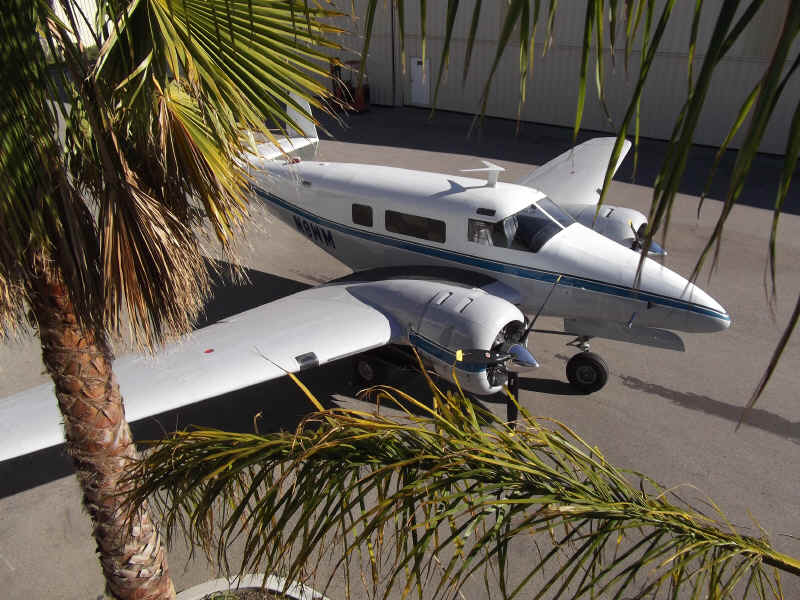
1954 Beech 18 (C45H) Volpar TriGear


Low total time: 6450 hours
Low engine times: 86 and 104 hours SMOH
3-blade Hartzell propellers 25 hrs SMOH
Executive interior - never a freighter - in excellent shape
10 seats: 2 front, 4 club, 2 bench seats with 2 each, including potty.
C45H means the entire plane was zinc-chromated in 1954
New Cleveland wheels and brakes
330 gallon wet-wing fuel system; only two tanks, Left and Right
Huge wing-locker storage in each wing inboard of engine
Aft Cabin storage behind rear bench seat
Wet bar with built-in cooler and outside drain
Cockpit doors provide privacy for passengers
Electric Elevator Trim
King KX-170B Nav-Com
King KX-175B Nav-Com
King KT-78 Transponder with encoder
King KMA-20 Audio Panel
Apollo GPS-360
Sigtronics Intercom
Bendix RDR-160 Radar
Annual dated 4/11/2012
Pitot-Static-Transponder test date 3/28/2012
ELT batteries replaced March 2012
see price next line down
Price: This plane has been sold. Sorry.
Send me an email or...
Call me with any questions
Cell Phone: 818-391-5087
The small pictures below are on 3 separate pages -- click on them.
Some Historical notes on 9WM
From Beech 18: A Civil & Military History by Robert K. Parmerter
"The USAF followed the U.S. Navy's lead in reconditioning and modifying its Beechcraft 18 models as a way of saving money in the postwar period of military budget cuts. The AAF had stored damaged and surplus Beechcraft trainers and transport aircraft since World War II; and with the outbreak of the Korean Conflict in June 1950, there was a need for updating the USAF inventory as quickly and cheaply as possible. Consequently, between 1951 and 1955, Beech put 900 World War II T-7 and T-7C (289), T-11 (420), C-45B (13), and C-45F (178) aircraft through remanufacture. Many were flown in to undergo this renovation, while 385 arrived in boxcars from Air Materiel Command bases such as Hill AFB in Ogden, UT (143), and Norton AFB in San Bernardino, CA (170). The destination for all arrivals was the former Air Force base at Herington, KS, about 75 miles north of Wichita. Beech leased it when the Korean Conflict erupted, and at times, as many as 100 duty-worn USAF Beechcraft 18s could be seen on the ramp.
Inside the Herington Beech plant a reverse-assembly line was operating with a crew of 700 to disassemble the aircraft. All airworthy and box car arrivals had the wings, tail assemblies, and engines removed, and if the engines needed overhaul, they were crated and sent to Love Field in Dallas, TX. All accessories were stripped from the fuselage, and the only fuselage and center section parts that were reused were the cabin door, the No. 9 bulkhead door, the nose baggage door, the landing gear doors, and some flooring. The remaining fuselage shell was placed in the "boneyard" outside the plant to be reclaimed for the price of the remaining metal. All wiring, control cables, hoses, fabric control surfaces, wing and tail-attaching nuts and bolts were replaced, and the reconditioned steel parts of the outer wing and tail were magnafluxed for defects. The suitable wings and tail surfaces were rebuilt at Herington, and with the rest of the reusable and reconditioned parts, shipped by railroad to Wichita. There, the rebuilt surfaces and parts were placed on new fuselage wing center sections on the regular Beech production line and sandwiched between commercial D18S models. Surplus and reconditioned P&W R-985 engines were used because new engines were no longer being manufactured. Propellers and other parts not available from the Herington operation were obtained from government stock.
The nine-hundred remanufactured C-45s were of three types: C-45G transport (372), TC-45G navigation trainer (96), and C-45H transport (432)."
This book is available through the Beech Heritage Museum. You can send an email to info@beechcraftheritagemuseum.org or you might reach them on the telephone at (931) 455-1974.
N9WM originally entered Army service at Childress, TX on March 3, 1943 as an AT-11. Mothballed in 1952 at Norton AFB, sent to the Beech Factory and emerged as AF-637, a C-45H, in 1954. Sold to Civilian use in 1961, she was given a major facelift in late 1963 and early 1964 to become a Conrad 10-2 Trigear and flying in Texas for a financial company. She changed hands and moved to California for the 70's and then headed for Florida in the 80's and eventually 'airplane jail' in Ft. Lauderdale. The official charge was "Illegal Registration". N9WM was confiscated and sold at auction. A couple of owners later she winked at me and begged me to go flying, just once.
After the second landing, while taxiing from the runway to the FBO in the last rays of the setting sun, a thought hit me that I was in a Twin Beech and not the Beech Travel Air B95A that I'd flown over a thousand hours. I was hooked. This is one of the best flying and handling planes ever made.
It's more stable than the Beech Travel Air in all aspects but at the same time just as maneuverable. Once you fly one you'll realize why the production that began in 1937 only ended in 1969 as the King Air emerged. This is the Twin Beech that all subsequent Beechcraft are descendents of. If you've flown a Beechcraft and liked the way it handled, you'll love this Twin Beech!